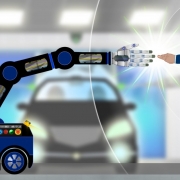Benefits of the new 5G technology for the industry
Considered a true technological revolution, 5G began its deployment some time ago. This new mobile communications standard, in continuity with the existing 2G, 3G and 4G standards, represents a great technological leap, since the features and application possibilities are multiplied by ten compared to previous technologies.
In fact, 5G improves people’s digital connectivity and now enables communication between sensors and devices that fall into the category of the Internet of Things, thanks in particular to the unprecedented broadband and level of reliability that this technology allows, comparable to the performance of wired technologies.
As the field of possibilities expands considerably, the world of industry is obviously no exception. A true competitive advantage, this new communication standard is the cornerstone of the smart factory of the near future. Up to 20 times faster than 4G, 5G enables data transmission latencies of up to one millisecond, and applications and devices that previously could only rely on wired connections to function reliably can rely on wireless technology.
In the factory of the future, operators will be equipped with highly efficient communication and vision tools that increase their productivity while facilitating access to machines. Under 5G in the factory, modularity and flexibility will be the watchwords. The various components of the factory of the future can be easily and seamlessly reconfigured as needed, relying on the reliability of the wireless infrastructure.
All these new perspectives, therefore, will make it possible to respond to the ever-increasing pressure of demand and present a real commercial potential. Investments related to the transition to the factory of the future will be constructive and will allow industry players to remain competitive by improving productivity. The operators will be more efficient, the costs and production times will be reduced and thanks to the modularity of the connected production units, the factories will be able to adapt more intelligently to the demand and thus produce more and better, in a reduced area.
Thanks to the connectivity between the machines, the factory will be able to have connected production units and thus create an intersection between the operational world, the machines, and the world of information technologies: the data. Crucial production data, such as temperatures, fluid pressures or times, will be collected directly from the machines, reliably transmitted and interpreted in real time thanks to data science and dedicated software. Therefore, manufacturers will be able to optimize the various stages of production and implement a global method of continuous improvement.
Many sectors, apart from industry, will benefit from this technological advance: transportation, with the use of autonomous vehicles, retail with improved shopping experiences, health and education. For companies, now more than ever, it is time to act and test new business models, to take advantage of the emerging opportunities represented by 5G, the Internet of Things and thus create new revenue chains, while satisfying the customer .
Some examples of 5G applications in the industry
With increased speed, higher real-time capacity, and greater flexibility, various industrial applications become much easier to imagine:
-The interaction between machines is an essential notion to increase the distribution of intelligence in factories. Equipment capable of self-monitoring can communicate with other parts of the process to optimize overall performance.
-Control loops that require very reliable real-time control and a very short cycle time can operate on their network segment without experiencing the disruptive effect that another component, such as a camera, might have on network stability.
-Wireless sensors allow better control of operating temperature, vibrations and noise emissions in production machinery, triggering an alert if any of the parameters exceed established thresholds in a given period of time.
-Autonomous vehicles are easier to operate with 5G, as they use cloud-based intelligence to deliver materials just-in-time to the factory, or even synchronize to distribute large loads between them.
-Augmented reality (AR) will allow operators to visualize in real time and directly on the machine all the important information about its operating status. And if they can’t solve a problem, what they see can be relayed over 5G to an expert who can remotely take pictures or point out a component.









